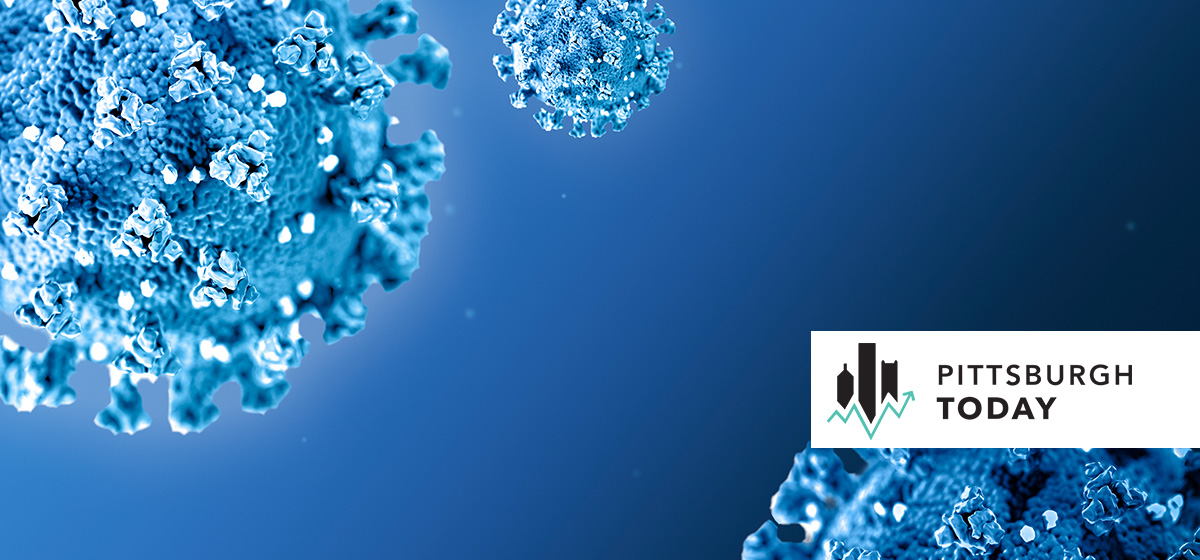Pitt Scientists Gain on COVID

In February, University of Pittsburgh scientists began scanning their library of human antibodies for any that might have the potential to tame the novel COVID-19 virus. With some 1 trillion antibodies to sort through, it was like looking for a needle in a haystack.
They found one in less than a week using techniques that didn’t require waiting for samples from infected patients who’d survived the disease, which is the traditional path to effective antibody treatments.
And in doing so, they added another chapter to the scientific advances demonstrated during the race against the coronavirus that have led to the development of several promising vaccines in record time and armed science with potent weapons against future viral threats.
On the hunt
Pitt scientists confronted COVID-19 with the advantages of having a powerful tool to quickly screen for antibodies with specific characteristics and a large, diverse collection of antibodies to search.
Using “phage display,” they were able to study the interaction of proteins on a large scale. Billions of proteins, such as antibodies, could be scanned in a week or less to identify those that meet certain specifications—in this case, neutralizing COVID-19. The technology had earned George Smith, a University of Missouri scientist, and Sir Gregory Winter of the University of Cambridge a Nobel Prize in 2018.
The size and diversity of antibody “libraries” available to researchers to sort through are critical to rapidly finding candidates with characteristics that give them the best chance of preventing and treating specific viruses.
Over the past few years, researchers at Pitt’s School of Medicine had built one of the world’s largest libraries of antibodies: 10 separate libraries, in fact, where upwards of one trillion antibodies—all human cells—are stored in a freezer under lock and key.
With such a large collection of antibodies, the challenge is to find a way to efficiently weed out those that don’t fit the profile scientists are seeking and identify those that do. “It’s a bit of an art,” said John Mellors, chief of the Division of Infectious Diseases at Pitt’s School of Medicine. “It’s like panning for gold. But, it’s like panning the entire Colorado River for gold.”
A team of scientists led by Dimiter Dimitrov found a way. For starters, they had a good idea of what to look for back in January when Chinese scientists sequenced SARS-CoV-2, the coronavirus behind the COVID-19 pandemic.
More than a decade earlier, Dr. Dimitrov’s team had studied a similar coronavirus, SARS-CoV, which caused a small international outbreak in 2003. They learned how its spike protein enables the virus to enter human cells and that part of it could be used to identify antibodies that step up to fight the disease. That tiny piece of the puzzle became their guide as they hunted for one to use against COVID-19.
“When the [COVID-19] sequence became available, we immediately made that small part. We had the bait.” said Dr. Dimitrov, director of the University of Pittsburgh Center for Antibody Therapeutics.
Most antibodies in Pitt’s huge collection didn’t respond to the bait in a way that suggested they could block the virus from attaching to and entering cells, which is the key to neutralizing it. But several showed promise. The researchers analyzed top candidates and identified the strongest of the batch, which they named ab1.
It took them only six days to discover it.
In the months that followed, they tested it in hamsters, regular mice and mice genetically engineered with the entry point COVID-19 uses to attack cells. The tests showed ab1 to be effective at preventing COVID and in treating infected animals to aid their recovery.
Clinical trials to test ab1 in humans are expected to begin early next year.
Science marches on
Several antibody treatments have recently emerged in the race against COVID-19, including promising monoclonal antibodies. Monoclonal antibodies, such as those identified by Pitt scientists, are laboratory-made proteins designed to fight off certain viruses or other harmful invaders.
In November, the U.S. Food and Drug Administration approved the emergency use of two monoclonal antibody therapies in COVID patients. Bamlanivimab, and a cocktail of the monoclonal antibodies casirivimab and imdevimab, were authorized for patients with mild to moderate cases of the virus. Clinical trials suggested they help prevent infected patients from developing severe cases of the virus that lead to hospitalization.
Monoclonal antibody therapies are generally more expensive and more difficult to make than conventional treatments that rely on antibodies taken from surviving COVID patients whose bodies made them after they were infected. But monoclonal antibodies have several advantages, including speeding up the response to a new virus. Rather than wait for samples from people infected by a virus, researchers can make monoclonal antibodies in the lab once the genetic sequence of the virus is known and jump start the development of treatments.
As important as that development is, the highest-profile scientific achievement of this pandemic year is the astonishingly rapid development of promising vaccines that could prevent people from being infected with COVID-19 altogether.
Anti-viral vaccines typically take years if not decades to reach patients. Until now, the mumps vaccine was the quickest to go from the lab to approved clinical use, and that took four years. But a COVID-19 vaccine developed by Pfizer and German drug maker BioNTech has already been approved for emergency use in the United Kingdom after the company reported that clinical trials suggest it is 95 percent effective at preventing infection, on average. Another company, Moderna, reported similar results for its COVID vaccine.
Both are awaiting FDA approval for use in the United States. Both drug makers said they could begin vaccinating patients by the end of the year. And both of the vaccines use a synthetic form of coronavirus genetic material, mRNA, to program a person’s cells to ward off the virus, a technology never before approved for such use.
Questions remain, including how long the vaccines will protect patients from the virus. But the new vaccine platforms, antibody therapies and remarkably efficient methods of discovering them demonstrate how scientific progress made in the teeth of the COVID-19 pandemic has sharpened the ability of medicine to more quickly respond to dangerous pathogens now and in the future.





